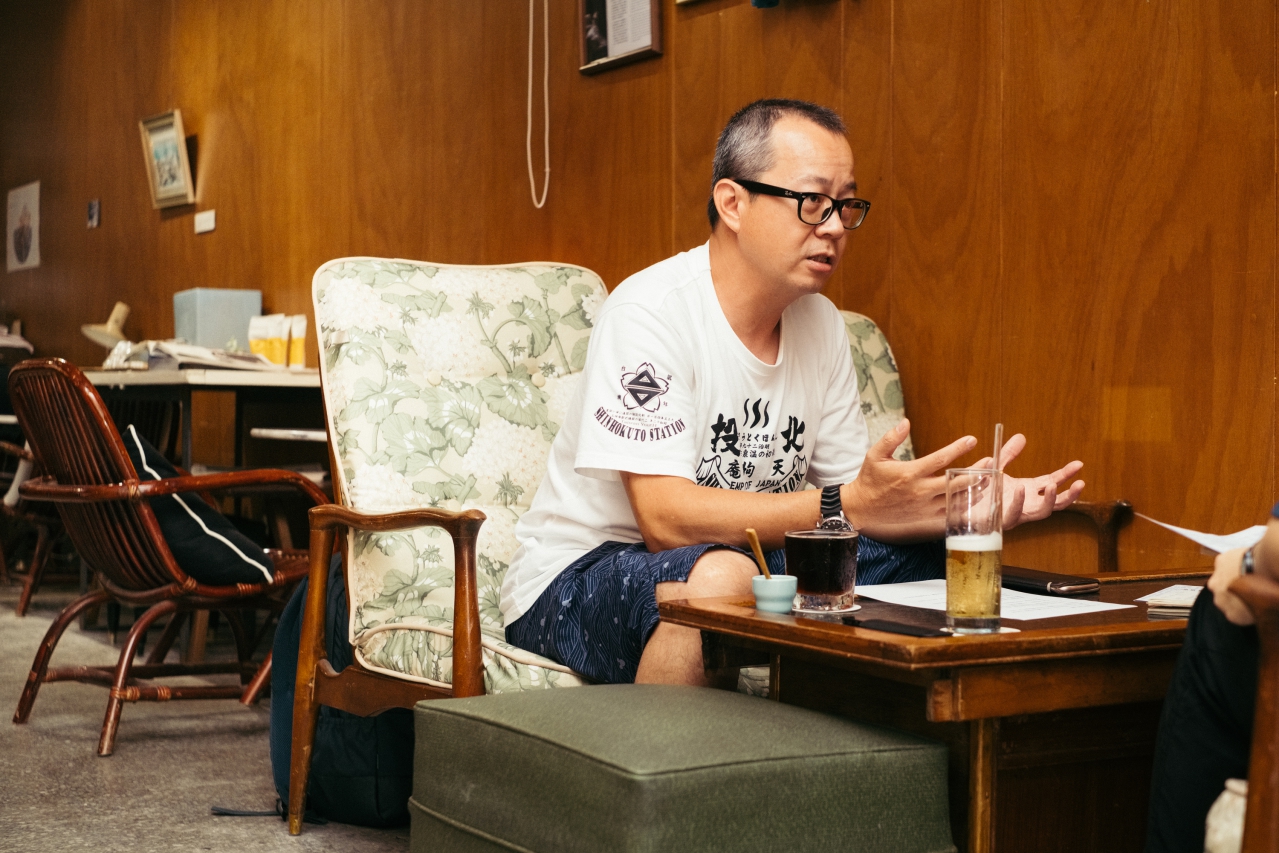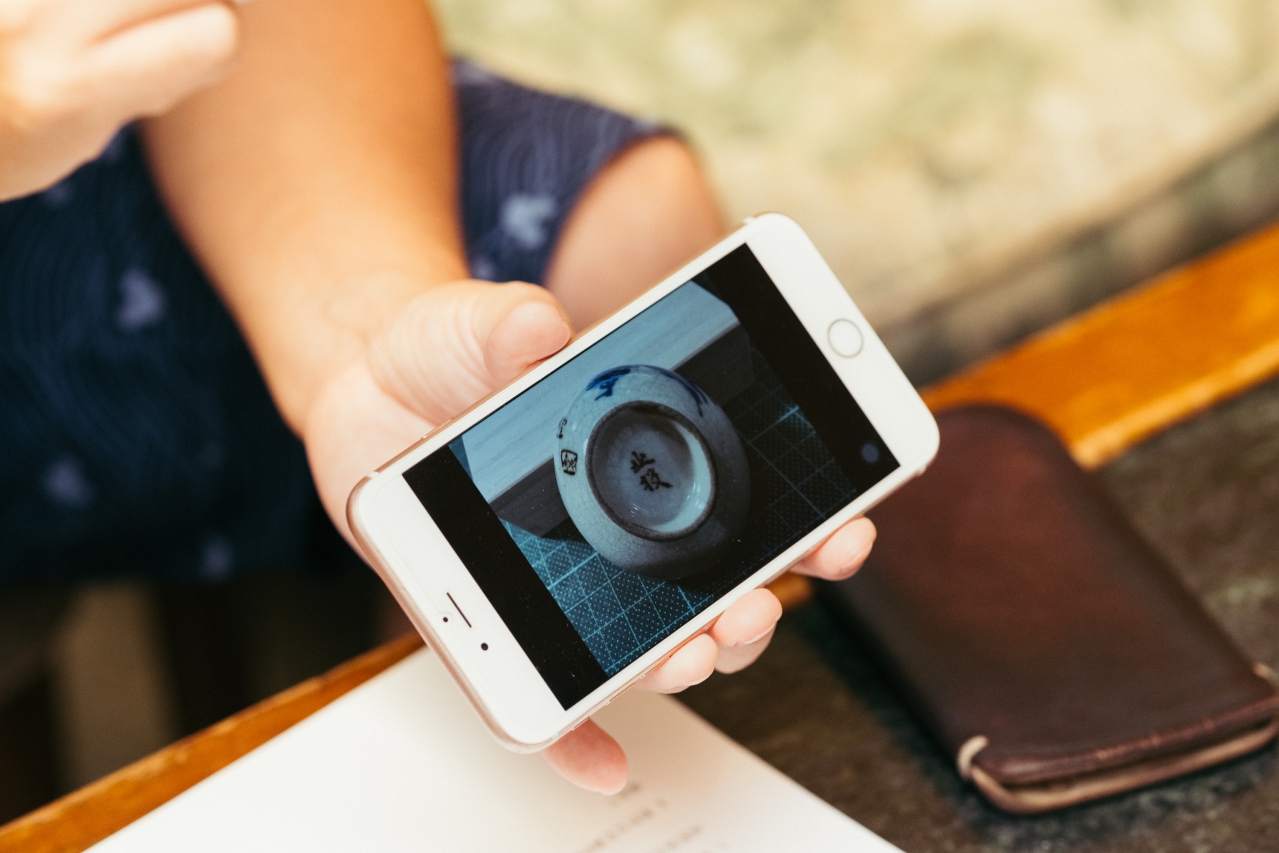楊燁說,最近這幾年,才比較習慣被稱作「文史工作者」,畢竟自己並非相關專業出身。雖然這樣講,但他對文史工作的熱愛和堅持,卻不在話下。為什麼呢?或許也不是什麼太特殊的原因。他成長於北投、生活於北投,研究並收藏家鄉的物件,對他來說是一件很自然的事。
楊燁出生於大稻埕,2、3歲時家裡搬到北投,在那裡度過悠長的童年。當時印象最深刻的,是愛好歷史的父親假日會騎車載著母親和他,到全臺各地如紅毛城、龍山寺等古蹟勝地遊玩,並講述歷史故事。這種看似平凡的家庭活動,卻像一顆種子埋在他心中。「那是我對『歷史』有興趣的開端。」楊燁說。
小時候沒想過把興趣當飯吃。楊燁喜歡歷史,也喜歡繪畫,但學校成績不出色,參加美術教室也不被傳統學派的老師青睞。國中畢業報考復興商工美術科,考試當天卻因腮腺炎昏倒,只能回家休養。這一休就休了一年,他去了汐止的白雲禪寺當小沙彌,跟隨廣化法師學習,每天拜佛108次,法名「淨燁」。法師看他喜歡畫畫,說佛教《大藏經》裡有一部佛說《造像量度經》,專門教導如何繪製佛像,不如拿來看看?他就這樣一邊學習正統佛像繪製的尺寸、角度,一邊修行。隔年考季再度來臨時,法師叫他要再升學多讀點書,他便因此忠告而還俗了。
之後像普通的學生一樣,到工廠打工、談戀愛,唸完復興美工。真正展開「文史工作」是1993年退伍後,在埔里的石雕公園工作期間。楊燁開始鎖定鄉下的聚落,跑去找老人家聊天。起初是彰化線西鄉,因為那是母親養父的家鄉。他造訪外公的老家,見到外公的弟弟,了解英年早逝的外公在日本時代曾當過日本兵、到海外打仗、回臺後又赴彰化銀行任職的生平,宛如一場家族回憶的巡禮。然後,又繼續拜訪彰化、埔里一帶的村落。這些地方有工作能力的年輕人都離開,只剩老人和幼童,大家看到他有心來採訪,都很熱情招待。
「當時臺灣各地,還有很多日本時代留下來的建築和生活器物。我本身對這些物件很有興趣,老人家發現你喜歡,都要送你,但我不敢要。事後回想覺得那時真笨,要是收下來就好了!」他打趣地說。
雖然沒接受老人家的心意,還是留下不少錄音和攝影。這些紀錄沒有地方發表,也不被視為專業嚴謹的田野調查,但重點是,他心中的熱情因此被點燃了。他益發投入其中,甚至動念想走遍全臺大小鄉鎮,後來發覺數量太龐大不可行,遂把範圍限縮回自己的家鄉北投。從此,正式成為一位研究北投的「非正式」文史工作者。

細究楊燁針對北投的文史工作,可以分成幾個面向。首先,當然是延續之前的考察和訪問。還在埔里工作時,就開始零星返回北投作採訪,同時爬梳文獻資料;2003年正式返鄉定居後,更全力投入其中。
他的老家位在如今的新北投,那裡因為最早被日本人開發的地區,相關的影像和文字資料較多。但即便不乏論文,研究者卻通常會以外來的「他者」角度,剖析此區的變化,難免少了一點「生活感」。這樣一來,閱讀的人獲得的,終究是「他者的北投」。對他來說,講到北投溪,與其按年代介紹其周圍環境的漸變或流域的分佈,不如聊聊日本人曾在溪上建造的七星橋、大屯橋,是多麼美麗;與其談論溪邊的溫泉產業曾帶給大人們多少的金錢和歡愉,不如想想北投溪昔日其實也是孩子們的玩樂場,在溪側和其間的沙丘跳來跳去,或利用淤沙捏成泥球互砸,都是他童年最珍貴的時光。父母忙著工作,小孩忙著玩耍。雖然也熱衷「尪仔標」一類的遊戲,但北投小孩的道地冒險,卻是跑到鄰近的貴子坑,撿拾窯場剩下來的彩色碎磁磚,或去復興公園後面的「神祕蛋工廠」試手氣,看能否撿到報廢的玩具。「神祕蛋」即如同早年的扭蛋,倘若手頭有餘裕,投零錢、按下鈕,就能聽到一段音樂從巨大的機器流瀉而出,接著吐出「神祕蛋」。「玩一次大概可以吃一碗麵線,但小朋友才不管,覺得玩具比吃的東西重要!」
除了整理相關資料,鍥而不捨進行的還有收藏,而這只能以「上癮」來形容。之前於埔里一邊工作一邊進行鄉鎮訪問時,雖然沒收下受訪者的禮物,但很常去彰化彰南路的古董店挖寶,當時購買的數量,就已經多到讓當時的臺灣省文獻會慕名而來,買下他的整批收藏。
回到北投後當然也不手軟。他特別鎖定照片,想透過影像回溯新北投地景的變化,尤其講起溫泉產業人盡皆知,但要說從前的溫泉旅館長什麼樣子,可沒多少畫面留存。為此他頻繁造訪資源回收廠,低價購入別人家整捆丟棄的老照片,更前進全臺的跳蚤市場尋尋覓覓。後來攤販們口耳相傳,都知道有這麼一位「北投狂人」,巡遍大江南北苦心收藏北投文物。某次在高雄,找到一批很想要的老照片,老闆竟不願割愛,「他說要賣給傳說中,專門在收集北投文物的『北投肖仔』,不管開多少錢對方一定會收。老闆不知道我就是那個人啦!」他自嘲。還不忘反省難道真心換騙局,大家因此認為可以亂敲他竹槓?
收藏靠努力、靠門道、靠口袋,但最重要的是靠機緣。無法抵擋器物魅力的楊燁,很早就從文獻裡發現「北投燒」的存在,卻在2019年才終於入手。那是一只直徑不過掌心,色澤如玉,內裡還有細緻手繪花樣的酒杯。貌嬌小,來頭大,因為「北投燒」最早是由臺灣第一家溫泉旅館「松濤園」的老闆,另外成立的「北投陶器所」所出產;這家窯場後來變成「北投窯業株式會社」,持續推出「北投燒」,卻和先前的版本有微妙的不同。「北投陶器所」時代,會先在杯底用毛筆沾黑色釉料寫上「北投」二字,再去燒製;「北投窯業株式會社」則不在底部落款。楊燁所得為前者,不僅底部有「北投」,杯身也寫上「松濤園」,再加上內裡的紋樣,怎麼看真的都是寶。這批文物在臺灣至今殘存不超過20件,珍稀異常,能意外從友人那邊買到,也讓他心花怒放。
 因緣巧合而購得的「北投燒」是由臺灣第一家溫泉旅館「松濤園」的老闆所成立的「北投陶器所」出產,杯底用毛筆沾黑色釉料寫上「北投」二字。圖 © 臺灣當代文化實驗場,朱淇宏攝影
因緣巧合而購得的「北投燒」是由臺灣第一家溫泉旅館「松濤園」的老闆所成立的「北投陶器所」出產,杯底用毛筆沾黑色釉料寫上「北投」二字。圖 © 臺灣當代文化實驗場,朱淇宏攝影
有得到,也有分享,文史工作便瞬間豐富且立體起來。但分享不一定得找一個空間展示自己的收藏。用畫的,用說的,同樣能把北投的特色告知更多人。
繪畫本來就是楊燁的專長,最早替南投縣立文化中心繪製導覽圖,尺幅達2乘1.6公尺,深獲好評,便陸續受各縣市委託製作地圖。2012年在北投溫泉博物館展出的北投鳥瞰古地圖,更獲國科會數位島嶼典藏的肯定。他會實地考察,了解地方流變,最後結合類似日本浮世繪般的藝術手感完成作品,被譽為「手繪地圖達人」並不為過。
「口說」的部份則是導覽。他和「北投說書人」等文史團隊合作,帶團遊逛北投,而且除了必去的溫泉相關景點以外,不忘踩點宗教場域。他尤其覺得寺院才是北投的亮點,諸如普濟寺、或被設為市立古蹟的真言宗石窟建築群,雖然得爬點坡方可抵達,帶團卻絕不會漏掉。克服坡度的建築結構,窗台轉角和斗拱收邊的「金具」裝飾,屋瓦末端象徵寺院派別的徽紋,皆為他認為不可錯過的重點;像普濟寺有著立體烏龜造型的裝飾瓦,猜測是和代表北方的守護神玄武有關。
 常常受邀進行北投導覽的楊燁認為逛遊北投的亮點不僅是溫泉景觀,許多寺廟更是值得一看。圖 © 臺灣當代文化實驗場,朱淇宏攝影
常常受邀進行北投導覽的楊燁認為逛遊北投的亮點不僅是溫泉景觀,許多寺廟更是值得一看。圖 © 臺灣當代文化實驗場,朱淇宏攝影
這兩年的新功課是爬山,因為發現臺灣很多古道,設有日本時代的駐在所,從前日本人在那裡活動,留下不少器物如酒瓶。「我收集很多日本時代溫泉旅館的帳單,他們會點菜、點酒,但沒有實際的文物可以對照。發現山裡面有,便勤奮地入山尋覓。現在收集的酒瓶種類,應該超過50種了吧!」像其中一隻「櫻麥酒」,可以對應到之前日本女星天海祐希主演的日劇《鈴木商店的當家娘》,其中鈴木商店因樟腦發跡,在北投有過分店,其經營的「帝國麥酒株式會社」生產的「櫻麥酒」,瓶身有櫻花圖騰,中間單一「帝」字,完全呼應了歷史。另外也從花蓮太魯閣的海鼠山,撿到北投窯業的耐火磚。群山簡直是聚寶盆,每一次造訪都有新發現。
興致勃勃地爬山,只為多挖掘一點古物,楊燁投入近30年,文史工作已非工作,而是志業。雖然不是相關背景,雖然沒有賺大錢,雖然耗費大把時間和精力也不見得有回饋,但他喜歡,所以繼續下去了。說起來,或許也和幼年出家得到的洗禮有關吧,志業像一種修行,不需與外人道。歷史無聲,所以這條路必然沉默。但只要心如明鏡,心便自在,也就沒有什麼好擔憂的了。